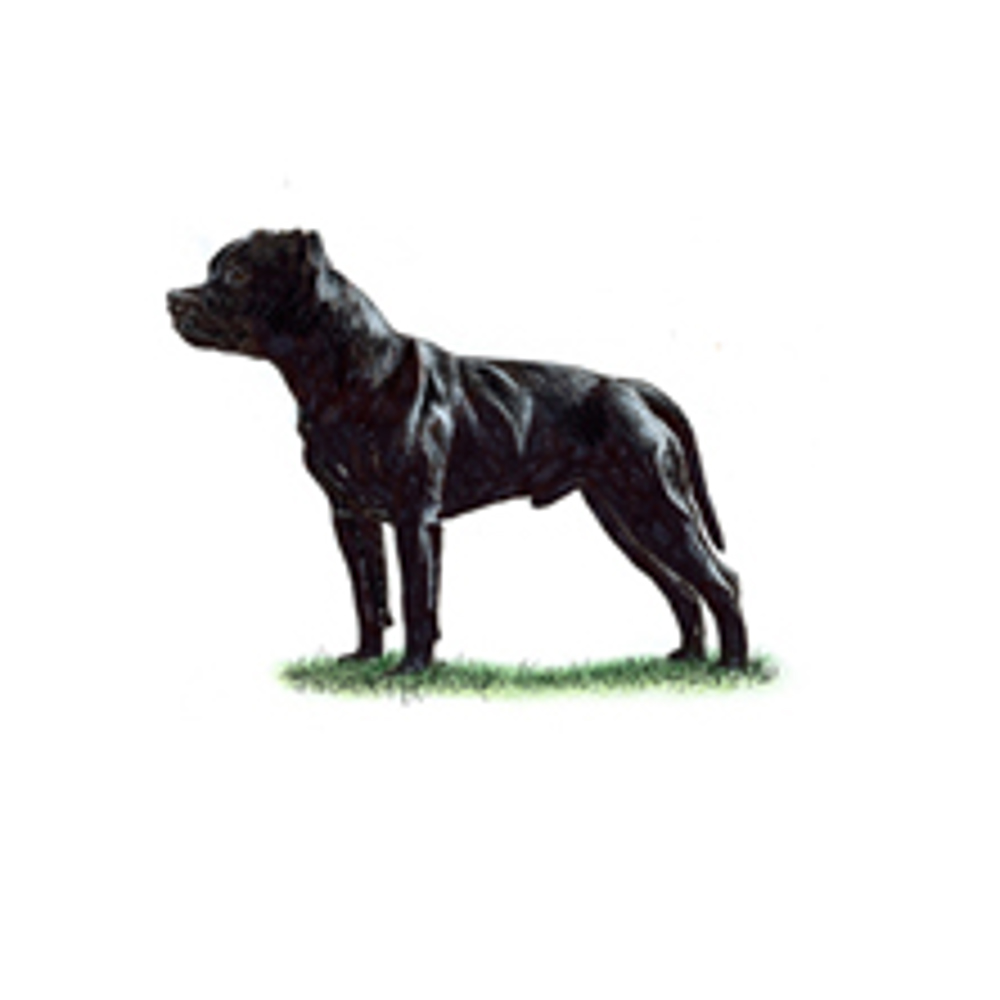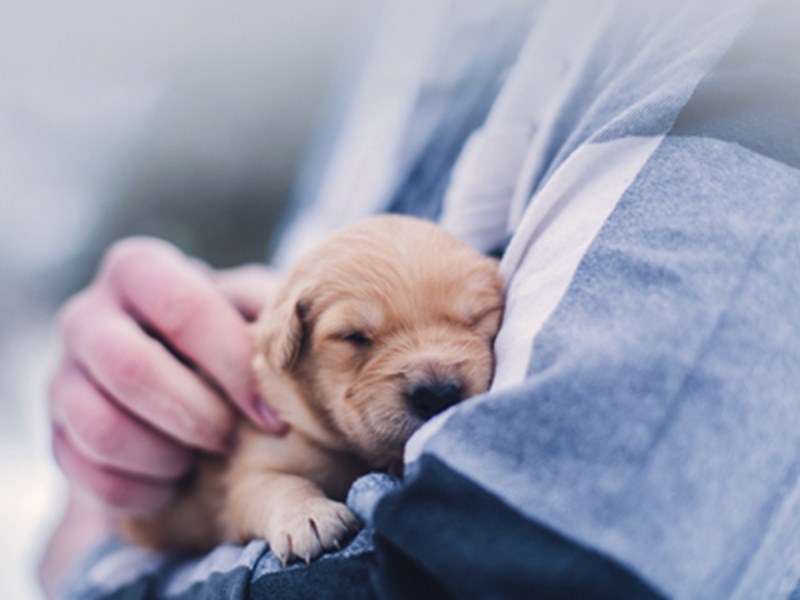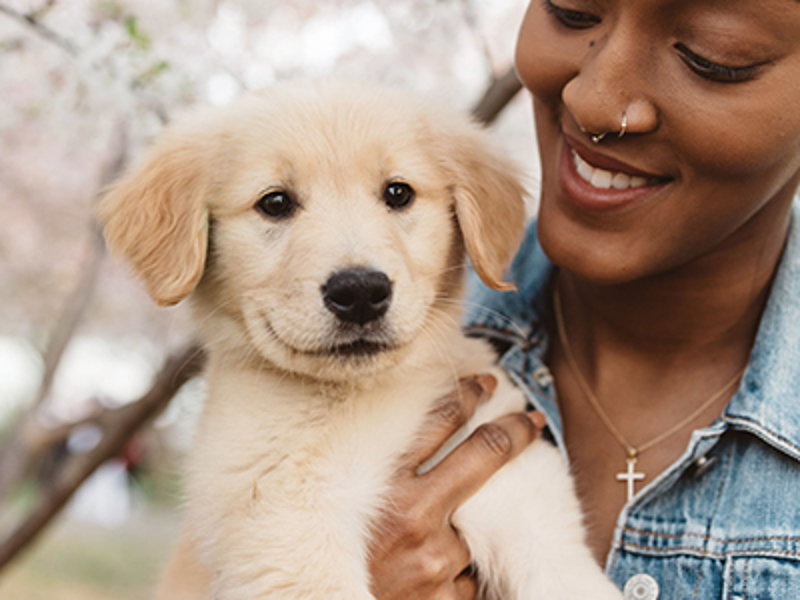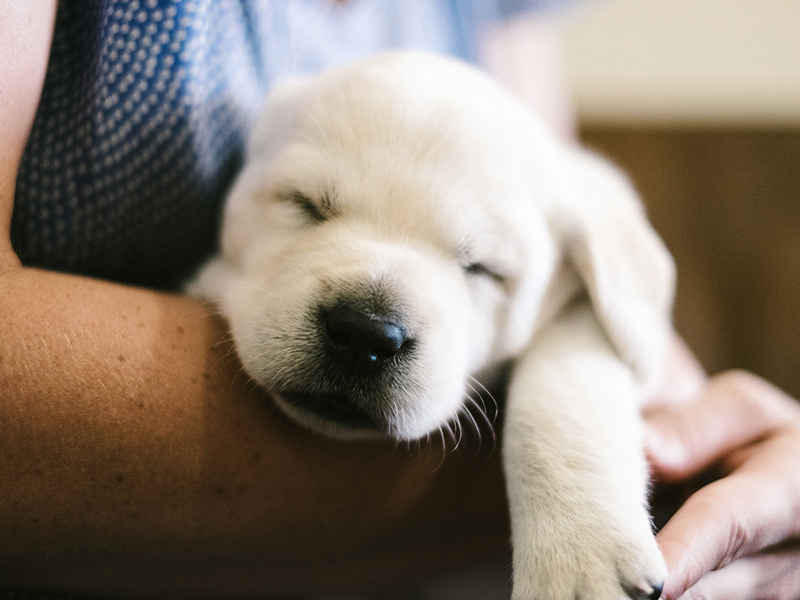
Staffordshire Bull Terrier
Breed characteristics
- Size
- Small
- Exercise
- Up to 1 hour per day
- Size of home
- Small house
- Grooming
- Once a week
- Coat length
- Short
- Sheds
- Yes
- Lifespan
- Over 12 years
- Vulnerable native breed
- No
- Town or country
- Either
- Size of garden
- Small/ medium garden
About this breed
The Staffordshire Bull Terrier shares the same ancestry as the Bull Terrier, which was developed in the 1860s by James Hinks who crossed Bulldogs with terriers and other breeds to develop a new type of dog for vermin control and blood sports. When Hinks later added other terriers and breeds, some that changed the head shape, of the breed, devotees of the original type of Bull Terrier cross remained loyal to their preferred type, from which the modern Staffordshire Bull Terrier is derived. It was not until the 1930s that The Kennel Club recognised the breed. It carried the name Staffordshire as the breed was developed in the Black Country of Staffordshire and northern parts of Birmingham.
Unlike other breeds it is shown traditionally in a broad leather collar ornamented with brass emblems, containing the Staffordshire Knot – as a tribute to its origins.
Despite its rough and ready beginnings, the Staffordshire Bull Terrier is known as a wonderful family pet. Their intelligence and affinity with children are noted in the breed standard.
Images for this breed
The Terrier breed group
Dogs originally bred and used for hunting vermin. 'Terrier' comes from the Latin word Terra, meaning earth. This hardy collection of dogs were selectively bred to be extremely brave and tough, and to pursue fox, badger, rat and otter (to name but a few) above and below ground. Dogs of terrier type have been known here since ancient times, and as early as the Middle Ages, these game breeds were portrayed by writers and painters.
Colour Watch
Category 0: Breeds with no NBS colour registration options.
Read more about Colour Watch.
Breed Standard colours
Breed standard colour means that the colour is accepted within the breed standard and is a traditional and well-known colour in this breed.
Breed standard colours in this breed include:
- Black
- Black & Tan
- Black & White
- Black Brindle
- Black Brindle & White
- Blue
- Blue & White
- Blue Brindle
- Blue Brindle & White
- Brindle
- Brindle & White
- Dark Brindle
- Dark Brindle & White
- Fawn Brindle & White
- Fawn
- Fawn & White
- Liver
- Red
- Red & White
- Red Brindle
- Red Brindle & White
- White
- White & Black Pied
- White & Blue Pied
- White & Brindle Pied
- White & Fawn Pied
- White & Red Pied
Other colour/s
'Other' means you consider your puppy to be a colour not currently known within the breed and one that does not appear on either the breed standard or non-breed standard list. In this instance you would be directed through our registrations process to contact a breed club and/or council to support you on identifying and correctly listing the new colour.
Non-breed-standard colours
Non-breed-standard colour means that the colour is not accepted within the breed standard and whilst some dogs within the breed may be this colour it is advised to only select a dog that fits within the breed standards for all points.
Colour is only one consideration when picking a breed or individual dog, health and temperament should always be a priority over colour.
Health
Whether you're considering buying a Staffordshire Bull Terrier puppy or breeding from your dog, it's important to understand the health issues that may affect the breed and how they can be managed or avoided.
Pre-breeding Health Screening
Good Practice schemes and tests
We strongly recommend that breeders, at a minimum, conduct these tests before breeding, as evidence indicates these conditions are a significant concern in the breed.
- Prioritising genetic diversity
Best Practice schemes and tests
These tests address conditions that are still significant for the breed, though they may not be as critical as those listed under Good Practice. They might be less common or newly identified, and research is ongoing to determine their full impact.
To support the breed’s health, responsible breeders should ensure they complete all tests in both categories. Following our Best Practice guidelines means completing both the Good Practice and Best Practice tests for your breed.
- DNA test for Hereditary cataracts (HC-HSF4-2) - Find a list of tested dogs here
- DNA test for L-2-hydroxyglutarate dehydrogenase (L-2-HGA) - Find a list of tested dogs here
- Elbow testing (for elbow dysplasia) using the BVA/KC Elbow Dysplasia Scheme
- Eye testing using the BVA/KC/ISDS Eye Scheme (including litter screening)
This breed also has a breed club health scheme, with further information available here
This breed can be affected by conformational concerns, more information can be found here.
Find out about a particular dog's results
Please visit our Health Test Results Finder to discover the DNA or screening scheme test results for any dog on The Kennel Club's Breed or Activity Register.
You can also view the inbreeding coefficient calculation for a puppy's parents, or for a dog you're thinking of breeding from.
DNA Testing Services
To support your health testing journey, we provide our tailored Staffordshire Bull Terrier Breed-Specific Package (with DNA profile included). Giving you the information you need about potential health risks, this package includes screening for Hereditary cataract (HC-HSF4), L2-Hydroxyglutaric aciduria (L2-HGA), DNA Profile (SNP - ISAG 2020).
3 essential tests valued at £175 for just £150, that screen for multiple conditions at once, saving you time and providing vital health information. 
Breed Health & Conservation Plan
The Breed Health and Conservation Plans
Our breed health and conservations plans (BHCPs) use evidence and data to help us understand the health issues found in each pedigree dog breed. These plans help breeders and owners identify health and welfare problems and use information, health tests and health schemes to avoid passing on those problems to future puppies. They also support and provide breeders with tools and specialist expertise to help manage genetic diversity, understand the impacts of close breeding, and find the best ways to preserve the population of their breed.
Working together for the breed
We’ve worked with breed clubs and breed representatives to gather all available evidence to help us determine the priority concerns for the breed and decide how we can work together to manage and reduce these problems.
Breed priorities
The current key priorities for the breed are:
- L-2-Hydroxyglutaric aciduria (L2-HGA)
- Skin conditions
How we plan to make improvements
We’ve agreed the following list of actions with the breed clubs to improve the health of the breed. Both parties are committed to working on these areas and will review these on a regular basis to ensure the actions remain focussed and relevant to the breed’s health.
Breed Club actions include:
- The Breed Clubs to continue to liaise with The Kennel Club Genetics Centre and ourselves with respect to L2-HGA affected dogs in the breed – IN PROGRESS
- The Breed Clubs to continue to encourage uptake in eye and litter screening
- The Breed Clubs to continue to encourage patellar screening and collate results
- The Breed Clubs and ourselves to explore collaborative routes in raising the profile of L2-HGA amongst breeders, puppy buyers and veterinarians
Our actions include:
- To repeat the breed’s population analysis. – IN PROGRESS
- To explore the possibility of developing a reporting database to allow for monitoring of conditions in the breed – IN PROGRESS
- To continue to monitor skin and cancer research relevant to the breed
- To explore the possibility of developing a formal patellar screening scheme to allow for recording of results
- To explore relevant cruciate research where the breed could be included
The full evidence base is available at the discretion of the breed clubs, however if you would like to seek access to the full report, please contact our health team.
Health (The Kennel Club)
How do I use this information?
Breeders should be mindful of the top priorities in their breed and ensure they are working to reduce and eliminate the presence of these diseases when choosing to breed their dogs.
Puppy buyers should also be aware of these issues and be sure to ask their breeder how they are contributing towards the above actions, and whether any of these problems have been seen in their breeding lines.
More about health
Have any questions about health in your breed?
If you have any concerns about a particular health condition in your breed then you may wish to speak to your vet or you could contact your breed health co-ordinator.
Breed health co-ordinators are individuals working on behalf of breed clubs and councils who are advocates for the health and welfare of their chosen breed. They acts as a spokesperson on matters of health and will collaborate with The Kennel Club on any health concerns the breed may have.
To contact your breed health co-ordinator please email either
Gemma Rowe
or
Nicky Mason
Breed watch
Category 2
Particular points of concern for individual breeds may include features not specifically highlighted in the breed standard including current issues. In some breeds, features may be listed which, if exaggerated, might potentially affect the breed in the future.
Breeding restrictions
There are a number of The Kennel Club's rules and regulations that may prevent a litter from being registered, find out about our general and breed specific breeding restrictions below.
More about breeding
With effect from 5th January 2010, merle puppies whelped from a mating on or after this date will not be registered. This is due to associated health risks of impaired vision and hearing associated with the merle gene in this breed.
With effect from 1st January 2013, The Kennel Club will not register puppies whelped from a merle to merle mating born on or after this date. This is due to associated health risks of impaired vision and hearing associated with the merle gene in this breed.
Looking for a puppy?
Looking for a Staffordshire Bull Terrier? Explore our list of puppies and rescue dogs for sale near you.
More information

Need to find out more about a breed?
Use our Find a Club service where you can locate breed clubs that can offer support and advice.

Use our Find a Puppy service
The Kennel Club's Find a Puppy service provides contact details for breeders who have puppies available. Let's help you find your new best friend.

Get the best lifetime pet insurance
At Kennel Club Pet Insurance, we want you to focus on getting the best possible treatment for your dog without worrying about the cost.
